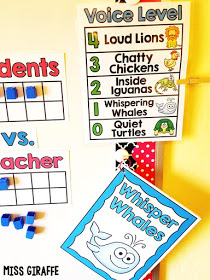Welcome to the second part of my classroom management series on dealing with blurters. These kids are just a special kind of friend and they call for a little bit of an intervention. Your typical talking strategies may not quite work on your blurters, so I have compiled a comprehensive list of strategies (some I've used, most I have not) for you to consider as you deal with these special friends.
I will be linking to several other teachers posts and TPT stores in this post because these strategies are not my own ideas. The purpose for this series for me was to put all the strategies together in one place to make it easier for teachers to find tools and tricks that they need to help them when they are struggling in a particular area.

I read about this strategy last year as I tried to deal with the fact that I had several sweet little friends who struggled with blurting out. All you need is a couple of containers and some beans. At the start of each lesson, I had my helper give each student a bean. If a student blurted out, their bean went back into the community container. All students who still had their bean at the end of the lesson or lecture, put theirs in the reward jar. It was as simple as that! You can pass out beans as little or as often as you like. I let students help me determine what rewards we were working towards. Just remember, the larger the reward container, the longer it will take to get there....This can lose its effect quickly if you don't pass out the beans often or if you make your container too large. I found this out the hard way last year.



When blurt beans weren't quite working for one of my little friends, I had to try something a little more drastic. I read about Blurt Cubes on Miss Giraffes post about taming a chatty class. You can read her post
HERE. This REALLY seemed to work for my guy for a while. Every time he blurted out, he had to turn one of his letters over. If he still had letters left by the end of the time we had determined, I let him go into my treat box.
For him, I felt that it was important that he didn't feel defeated if he lost all of his letters before the day was over so we decided that he got to reset and get a second chance at lunch time if didn't meet the goal. I think this really helped him think and reflect that "Hey, I need to do better this afternoon." I didn't want him to give up on the rest of the day because he had already lost his letters. This worked really well for him for a couple of months. As with everything else, things tend to lose their magic and you have to try something else. I do recommend this strategy for your high flyer blurters. Letting him determine what the reward was each time was also really helpful. He liked picking reward passes like lunch with a friend or having me buy him a snack a lunch.

For the Blurt Box or Bucket, students fill out a ticket or paper with their name and date each time they blurt out and interrupt the class. You want to make sure you have clearly defined what all qualifies as blurting out {making noises, talking to a friend while the teacher is talking, shouting out an answer without raising their hand, etc...). This way, your students are well aware of reasons they may receive a ticket for the blurt box. Students will drop their tickets in the blurt box. At the end of the week, tally the tickets and help students make a goal to improve their blurting. You can reward students who didn't blurt out at all. Students who beat their goal each week can earn a certificate or a note home.
I would use our data notebooks to help keep track of our weekly blurts because our school is big on Data Notebooks. This would be an easy way to help students keep track of their weekly blurts and it would be great to pull out during parent conferences so that students can show their parents their improvement.
Here are a couple ideas for a Blurt Box or a Blurt Bucket. Click on each image for the original post or link to the product.
Teacher mail, or T-mail, is a way to help keep your students from constantly blurting out to tell you things that have nothing to do with what you are teaching. You know the kids I'm talkin' about, right? These are special kinds of blurters! With T-mail, students fill out a little piece of paper and put it in your mail box. Instead of blurting, they are able to share with you appropriately and then you can respond to the student at a later time. If you don't have a mailbox, you can use a shoe box or some other container for collecting your T-mail. You can download this freebie from Upper Elementary Adventures by clicking the image below!


I have not used Talkin' Tokens, but this strategy is great for all students. Each students gets a few tokens. If you don't have the printable ones pictured below, you can use something like counters. Each time they contribute to the conversation or answer a question they give you a token. If they blurt, they lose a token. This is a great way to help students be conscious of their talking out and remember to raise their hands because they are tangible. You can read more about The Pinspired Teacher's post
HERE.
I kind of love this idea because it is similar to the Quiet Manager that I mentioned in
Part 1 of the series. A student is chosen to be the Blurt Patrol. The best part is you want to choose one of your special blurters for the job! You place the blurt patrol charts on a clipboard. You will want to discuss the voice level chart and the expectations at each level with your class when you introduce it. Before the lesson, set a goal for how many blurts you will make and try to stay under that goal. The blurt patrol then sits where they can see the whole class and the teacher. If the student sees someone blurt out for not raising their hand, having their eye on the speaker, or not having a level 0 voice, the blurt patrol gives them a silent warning by pointing to the part of the chart they need to fix on the back of the clipboard. If that student needs to be reminded again, the blurt patrol puts an x on the chart.The goal is to stay in the green with blurts. You can purchase this for only $1.50 by clicking the image below! I am definitely going to be trying this one out this school year!


Another simple idea you do for your blurters is to give them a punch card. This is one of those strategies like the Blurt Cubes that may lose its magic touch after a time. I personally think it is important to let students determine what reward they want or else they won't want to work towards changing their behavior. Every time the students get through a predetermined amount of time without blurting, they earn a punch on their blurt card.
You can download these reward punch cards free by clicking the image below.
The Pinspired Teacher also includes some Blurt Punch Cards in her Blurt Pack on TPT. You can head to her store by clicking the image below.
The Blurt Board is similar to the Chit Chat Chart I described in
Part 1. I really like this blurt board below. Student's names would be listed along the side. Then they have several velcro circles next to their names. Each time they blurt, they would remove a circle. Yellow is a warning. The first red circle and after, you would determine how to handle those in your classroom. We aren't allowed to take recess so we enforce silent lunch instead. Losing all 6 would most definitely result in a phone call home if it were me, but certainly you could determine how the chart would work in your class. I would definitely reward students who had all of their circles at the end of the week. I could not find the source for this photo for credit so if you know where this originated, please share.

In this one from Angela Watson, students get three pieces of bubble gum on the board a week. Each time they blurt, one piece goes back into the class gum bowl. For every piece they have left at the end of the week, they keep. If they have none, you determine a consequence.
I certainly hope you were able to learn some new tips for dealing with those pesky blurters! I would love for you to share your favorite way to handle them in your classroom in the comment section!
Don't forget to join me for the next part in the series, Tattling! You can also read last week's post below.





















































